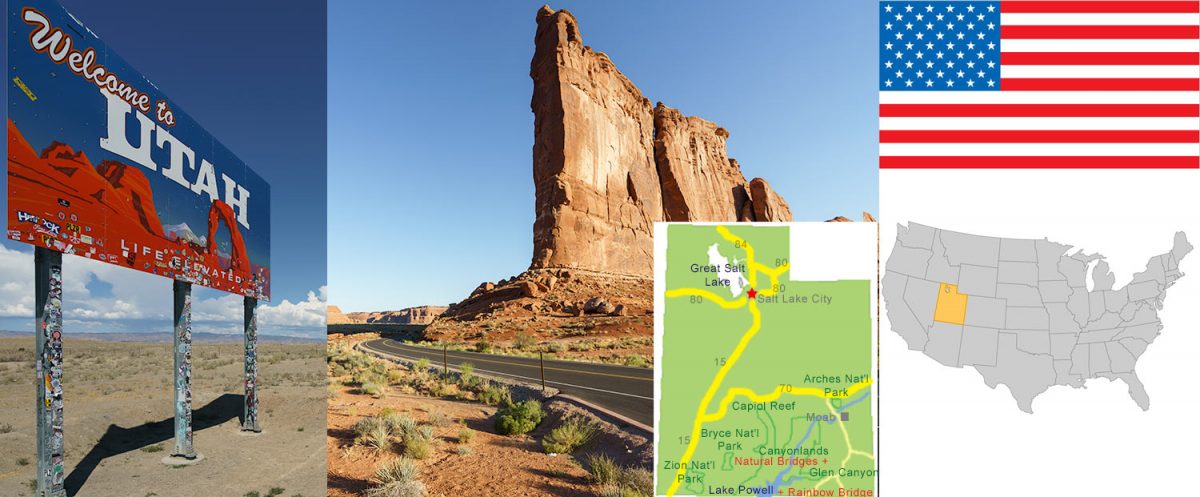
‘The Beehive State’
The beehive is also the state symbol and this should reflect the relation to the early pioneer’s virtues, such as perseverance, assiduity and thriftiness.
“This is the Place!” said Brigham Young, pioneer, leader of The Church of Jesus Christ of Latter-Day Saints, when he first saw the Salt Lake Valley on July 24, 1847. The Mormons turned the dry valley into a prosperous oasis.
The name “Utah” originates from the name of an Indian tribe, the “Ute tribe”.
The southern part of Utah is home to some of the most spectacular National Parks of the country, e.g. Bryce Canyon, Arches, Capitol Reef, Canyonlands, Zion and the unique Monument Valley.
The north around Salt Lake City is well renowned for its 14 ski areas/resorts: Park City, Deer Valley, Beaver Mtn, etc. – and not to forget that the Olympic Winter Games of 2002 took place in Salt Lake City.
Utah is also a great place for outdoor activities like Rafting, Mountain Biking, Kayaking, Horse-Back Riding and for Off-Road Fun.
Travel articles
All our Utah articles can be found in the category Utah and are as well tagged as Utah.
An overview of Utah
Some of the most colorful figures and outlaws of the Old West have claimed Utah as home. Utah’s prime location between California and the middle of nowhere created a sparsely populated landscape from which cattle rustlers and bandits could steal their way into western legend.
The wide-open area sheltered some of the West’s most reviled and revered cowboys. Old West outlaws including Butch Cassidy, Billy the Kid, and the Rough Riders all set up camp within Utah’s borders.
Most of the territory once dominated by the great cowboys is still untouched and can be conveniently visited today. Experience the living history of the Old West! The Old West way of life is still strong within Utah. Modern-day cowboys still ranch on Utah’s soil and Native American tradition and present-day customs have a strong influence on Utah’s overall cultural climate.
The state of Utah is unique
Utah has more variety of landscapes, geology, and recreational opportunities than you even can imagine. While the national parks are considered national treasures, there are many more places to see and things to do that are just as amazing… and certainly less crowded!
About Utah’s Landscape
Most of Utah lies on a plateau higher than 4,000 feet above sea level. The geology of this region takes on an amazing variety of shapes and colors. Elevations rise and fall dramatically in the shape of mountains, buttes, and plateaus, the highest reaching over 13,000 feet! Within this varied landscape are hidden treasures and experiences that appeal to everyone — from the rugged, solitude-seeking explorer to the family wanting a relaxing getaway. Utah has something for everyone.
Best time to travel / Season
Main season for South Utah is summer! Highest temperatures can be expected during these months as well as high prices for accommodation. Best time to travel is late spring and fall when temperatures become moderate and parks are not that crowded.
Winter time brings the main season for Salt Lake City and the ski resorts. The summer temperatures are much more moderate than in the south, so it’s a good idea to visit the Salt Lake area in summer if you are not a skier.
Climate and Temperatures
With regard to the climate Utah can be split up into 3 regions.
North-East (Salt Lake City area): the Rocky Mountain Region with mountains up to 4.000 m (13.000 ft). This is the skiing area of the state.
West and South West: the Utah Basin, which is the lowland, the plains. Temperatures here are high and the air is dry – it’s said it is one of the driest places in the US. The region is home to the Great Salt Lake, which is always worth a visit.
South and Southeast: the Colorado Plateau (Highland) which extends into neighbor state Arizona. This is the area where the major National Parks like Bryce Canyon, Zion etc. are located. Temperatures as well very high during the summer and the air is dry. Winters can be freezing cold, due to the elevation.
Southeast Utah is part of the Colorado Plateau, a “high desert” region that experiences wide temperature fluctuations, sometimes over 40 degrees in a single day. The temperate (and most popular) seasons are spring (April through May) and fall (mid-September through October), when daytime highs average 15 – 25 degrees C (60 to 80 F) and lows average -1 – 10 degrees C (30 to 50 F).
Summer temperatures often exceed 38 degree C (100 F), making strenuous exercise difficult. Late summer monsoon season brings violent storm cells which often cause flash floods.
Winters are cold, with highs averaging 30 to 50 F, and lows averaging 0 to 20 F. Though large snowfalls are uncommon (except in nearby mountains), even small amounts of snow or ice can make local trails and roads impassable.
Essential data

aaa
State Name
Utah – State Abbr.: UT
Statehood
4-Jan-1896
– Statehood Ranking: 45
Land Area
82,144 sqaremiles (212,745 qkm)
– Land Area Ranking: 12
Population
Ca. 3.1 millions (in 2019); 2,233,169 (in 2000)
Capital
Salt Lake City
Biggest City
Salt Lake City
Nickname
The Beehive State
Motto
Industry
Highest Point
4.100 m / 13,451 ft (Kings Peak)
Lowest Point
670 m / 2,198 ft (Beaver Wash Dam)
– Dayligh Saving Time
– yes
Tree
Blue Spruce
Flower
Sego Lilie
Bird
Calif. Sea-Gull
Animal
Rocky Mountain Elk
Song
“Utah, We Love Thee” (by: Evan Stephens)
Special Holidays
Pioneer Day (24-Jul)

